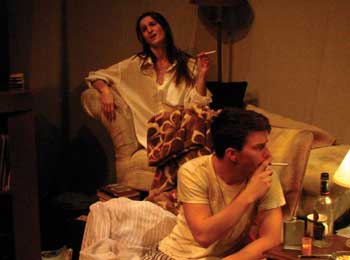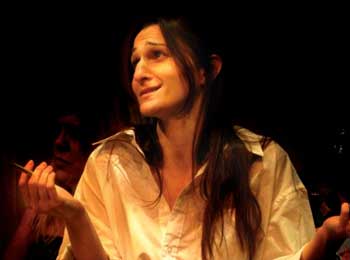World of the Play
Critic John Freedman has called Vodka, Fucking and Television, “a Janus-faced piece that can be read as a personal confession or a portrait of a generation" (87). That generation, “the transitional generation” to which both the playwright and the protagonist belong, consists of people who were born and raised in the Soviet Union, but reached adulthood in the early days of the new Russian Federation. The author precedes his play with an emphatic statement there is no relationship between the character and himself. Yet the play’s hero also happens to be a playwright. In response to a mid-life and artistic crisis, he decides that he must give up one of the three vices of the play’s title. The other characters in the play are Vodka, Fucking and Television. Vodka has both a personal connection for the author and special place in the history of his country. The appeal of Television, on the other hand, changed considerably for him since the fall of the Soviet Union. The place of Fucking in the play speaks both to the experiences of many human beings and to the particular dynamics of sexuality in Russian culture.
Freedman, John. “Maksym Kurochkin: A Writer for Paradoxical Times.” TheatreForum 32
(2008): 85–87. International Index to the Performing Arts. Web. 8 Oct. 2009.
Russia’s Transitional Generation
We were children during the Seventies. Now we’re dangling between two self-satisfied
generations, like an absurd pair of camel nuts. We are nobodies, we’re nothing. . . We’re not
entirely of this earth, although we’d like to be.
Hero, from Vodka, Fucking and Television.
A ten-year-old girl in Moscow was proud to have earned her red Pioneer scarf – the mark of a loyal young Soviet citizen. But the very next week, her mother informed her that she could no longer wear the scarf because the Pioneers, and the nation they were designed to support, no longer existed. Elsewhere in the city, a teenage boy riding down Tverskaya Street in the car of a family friend looked out the window to see a tank driving alongside their car – and stopping at the red light along with them. Both vehicles were on their way to Red Square along with thousands of fellow citizens. Across the nation that was once the Soviet Union, young people found the transition to adolescence and adulthood coinciding with a more dramatic transition for their country. Just as their parents and grandparents faced questions about who would lead their nation, what would become of their jobs and how they would feed their families if the expected salaries did not materialize, the next generation looked to an uncertain future in an uncertain era. In the early 1990s, Russia’s “Lost Generation,” Soviet citizens born between 1968 and 1978, saw their world change beyond recognition in ways both liberating and disorienting. At first this generation embraced these drastic changes. Flooded with images of freedom and prosperity, they were optimistic about the social and economic reforms. Unfortunately, in its haste to build a new nation overnight, the Russian government fell into corruption and economic difficulties. A few short years later, the young Russians were showing signs of disillusionment and hopelessness. They expressed “bitterness about failing new economic policies and increasing poverty and crime” (Adelman xii). Enthusiasm was replaced with apathy. Economic and political changes are the most obvious adjustments this generation encountered. Fifty percent of Russia was in poverty by 1992 (Poland 3). Work was not mandatory anymore, and although few could afford not to work, many found it difficult to find a job. When the communist machine was dismantled, the new leaders also removed the very social and economical structure that supported their country. Boris Yeltsin, Russia’s first popularly elected president, was dedicated to radical and rapid change. In order to switch to capitalism, he first had to destroy communism. He released the price of common products from government control, privatizing them, adhering to an economic theory referred to as “Shock Therapy.” Russia was not ready for this quick change and inflation caused prices to go up by 300% by the end of the first month. Before 1991, most of a family’s weekly groceries could be bought for a few rubles (it was 27.6 rubles to a dollar in ‘91). In 1991, due to the abandonment of agricultural subsidies, there were long lines and no food. Once inflation and poverty took hold, there was plenty of food but no money with which to buy it (Radio Free Europe). As economic changes crippled post-Soviet Russia, socio-cultural changes impacted the generation struggling to come into adulthood. Author Minaev recounts, “They said, forget about all the heroes, forget about the entire cultural heritage, forget about everything. We’ve changed the picture. Now survive” (Kishkovsky 1). An entire generation suddenly was expected to come into adulthood from a childhood based on cultural principles that were now rejected by their society. Everything that they were raised to believe was suddenly and completely wrong. Victor Pelevin, another best-selling author now in his 40s, believes they were the “generation that was programmed for life in one sociocultural paradigm but has found itself living in a quite different one” (Freidin 3). Hero’s struggle with Vodka, Fucking and Television, is also his struggle to find a place and a meaning in this shifting age. As Deborah Adelman says in her book The Children of Perestroika, “Theirs is a generation caught between rejection of the old ways and a full embrace of the new” (1).
Works Cited
Adelman, Deborah. The “Children of Perestroika” Coming of Age: Young People of Moscow Talk about Life in New Russia. Armonk: M.E. Sharpe, 1994. Questia. Web. 27 Sept. 2009.
“CIS: The Generation That Never Knew the Soviet Union”. Radio Free Europe Radio Liberty. Web. 22 Sept. 2009. Freidin, Gregory. “Pelevin Foreign Policy”. Foreign Policy. Web. 5 Oct. 2009.
Kishkovsky, Sophia. “The Tortured Voice of Russia’s Lost Generation”. The New York Times. 22 Dec. 2007. Web. 12 Sept. 2009.
Poland, Marshall. “Russian Economy in the Aftermath of the Collapse of the Soviet Union.” Web 29 Sept. 2009.
By Qituwra Anderson
Vodka
“Vodka is our enemy, so we utterly consume it.” This Russian proverb accurately depicts vodka’s role in Russian culture. Vodka is their enemy. This is true in several ways. Vodka like many other hard liquors, has been scientifically proven to be quite the health hazard. It produces negative health effects, both short and long term, especially when consumed often, in haste, in large amounts, or some combination thereof. According to the CIA World Factbook, Russian women currently have an average life span of 73.14 years, while Russian men, who on average drink more than women, have a life expectancy of 59.33. Part of this significant gap in life expectancy between the genders has been linked to alcohol related illnesses and deaths. The use and abuse of alcohol costs Russia’s businesses millions in revenue each year. Drinking is a major contributor to absenteeism and poor job performance. How bad is it? “One Russian chemical plant reports that 3.5% of its workforce were confirmed alcoholics, 2.2% showed early signs of addiction, and a further 18.8% were alcohol ‘abusers’, with only 1.4% abstainers. Between 75% and 90% of absences from work were attributed to alcohol. It was suggested that loss of productivity associated with alcohol was the main reason for the failure to achieve the Soviet Union’s 5-year plan in the early 1980s, with estimates that the loss of productivity due to alcohol was up to 20%” (McKee). Even former Russian President Boris Yeltsin, was known to slack off on the job as a result of his drunkenness. He has been filmed singing, dancing, and stumbling at political engagements. Political leaders past and present have attempted to cut down on the country’s drinking problem. Among their ranks are Russia’s current President, Dmitry Medvedev, who is attempting to reduce alcohol consumption by 25% by the year 2012, and former leader Michael Gorbachev who made sure the alcohol supply was cut down to ensure that consumption was lowered. However as a result of Gorbachev’s efforts, fights amongst angry customers began to increase. Hero in Vodka, Fucking and Television seems similarly unable to bear the thought of life without the drink, as he proclaims, “I can’t take this. I have to have a drink. I’m not going to write anything anyway. Goodbye Norway! Oh-oh-oh!! I feel vodka! Vodka is my enemy!” And yet, he still “utterly consumes it,” as do most Russians, particularly, men, who, on average consume about a pint of vodka every other day, which is twice the amount of alcohol that the average American male consumes. Why is vodka so popular in Russia? It originated there! Vodka has been part of Russian culture for over a thousand years. Russians drink vodka on special occasions as well as ordinary days. It is an important part of weddings, birthdays, social gatherings with friends, and is even used as a cure for illness. In the case of a social gathering with friends, a meal would also be served, and there would be a toast such as “May everything in your life be good.” Favored food choices while consuming Stolichnaya or Russian Standard (two of Russia’s popular vodka brands), among many others, include pickled herring, marinated cucumber, hot soups, hot potatoes, and red caviar. A Russian giving up vodka, is giving up a substance that can be dangerous and unhealthy. But he or she would also be giving up an important and longstanding part of Russian culture and tradition. The first documented production of vodka was in the 9th century, but vodka was not produced in mass amounts until the early 1400s, when fruits or herbs were often added to the vodka because the distillation process had not been refined and in contained many impurities. “In the 14th century a British Ambassador to Moscow first described vodka as the Russian national drink” (Gin and Vodka Association). Although it is now prohibited to advertise alcohol, recent Russian television commercials for this national drink have depicted it in a somewhat different light than what we are used to in the United States. One ad depicts vodka as being able to combat the negative things in life; the blizzards, the cold, the wilderness, and loneliness. At the end of the commercial, the actor declares that vodka is his friend, saying “Vodka Kreskova. My Russian Comrade.” Another commercial for a brand of vodka, Stolichnaya, highlights the drink as a symbol of Russia’s strong sense of independence. It begins with the Slogan “Stoli Vodka; Born in the Heart of Russia.” The commercial features Russian soldiers marching with Stolichnaya in their hands. Playing throughout the commercial is The Cossacks performed by the Red Army choir. Vodka seems to be as essential to Russians as friendship, independence, and patriotism.
Works Cited
CIA. “Russia: People.” The World Factbook. 9 Oct. 2009. Web. https://www.cia.gov/library/publications/the-world-factbook/geos/rs.html
https://www.cia.gov/library/publications/the-world-factbook/geos/rs.html
Gin & Vodka Association. “History of Vodka.” Cocktail Times. Web. 25 Sept. 2009.
Litvinov, Andrei. “Medvedev’s Anti-Alcohol Campaign Tries to Make Russia Sober.”
Newsweek. 4 Sept. 2009. Web. 1 Oct. 2009.
McKee, Martin. “Alcohol in Russia.” Alcohol and Alcoholism 34.6 (1999): 824-829.
Oxford Journals. Web. 5 Oct. 2009.
“Fucking” and Russian Society
by Abby Grimsley
Ludmila Ivanova, a member of the Committee of Soviet Women, famously stated on the Phil Donahue and Vladimir Pozner “Space Bridge” television program in 1986 that “there is no sex in the Soviet Union” (Lukanov). This statement is correct if one only takes into account what was happening on the surface of Russian society. Sex is a taboo subject; not one about which numerous people in Russia would talk openly. Yet in the decade and a half after the 1917 October Revolution - before Stalin came to full power – things were very different. Many Russian citizens considered talking about sex to be a part of everyday life (Carleton 7). There were still, of course, more conservative people who opposed this kind of conversation and wanted to keep sex in the private realm (8-9). Others, however, talked about sex with “no more reserve than of music, the theatre, the weather” (Hindus, qtd in Carleton 7). When Stalin came to full power in the late 1920s, his tendency to control the lives of the people living in Russia made it more difficult to talk frankly about sex. One way he did this was by abolishing sex education from schools, which ensured that the next generation was unable to have a well-informed discussion about the subject (Kon and Riordan). This culture of not talking freely about sex is still in effect in Russia today, even if the subject is perhaps more visible than before. In 2005, Moscow government officials started hanging posters all around the city that proclaim, “There’s no such thing as safe sex” (Chopen). Their campaign advocated total abstinence before marriage. Although the posters may publicly acknowledge the existence of sex, the promotion of this simple message has not removed the taboo around other open discussions of sexuality in Russia. By contrast, Maksym Kurochkin personifies sex as a character on stage so that everyone who experiences Vodka, Fucking, and Television is forced to acknowledge the existence of sex in a very public way. This openness in the portrayal of a taboo subject could lead one to believe that the character Fucking represents the private experience beneath the public silence on this topic. In a society that views sex as a private topic, however, how can one accurately determine the nature of private sexual experience in that culture? Many of the statistics that researchers are able to gather (when they can even find individuals willing to discuss the subject) can’t be regarded as being completely accurate because they are based upon the way people describe their sexual activity. Discrepancies in these numbers suggest that men tend to exaggerate and women under report. For example, one Russian survey studied by Igor Kon found that the average number of lifetime partners reported for men was twelve to thirteen and the average for women was four (169). Mathematically speaking, these numbers are quite improbable. Even though the population of women in Russia may be higher than the population of men, it is unlikely that it is that much higher. Other statistics show not only a gap between the reported number of sexual encounters of men and women, but different expectations about their experience of sex. More often than not, the man controls what happens during the course of intimate events than the woman (171). Married couples sometimes even feel uncomfortable talking about the sex that they are having together and the types of things that would make it better (172). Only a quarter of Russian women, for example, report always achieving orgasm during sex (Kon 166). These numbers are similar to those in the United States, where about thirty percent of women surveyed admit to always having an orgasm when they have sex (166). But, if a Russian wife tried to tell her husband where a particular erogenous zone was for her, he might get upset and want to know where she is getting this information (172). He might even suspect that she is seeing another man, and with good reason given the climbing rates of adultery in Russia (173-4). A little more than half of the men and about a quarter of women asked in one study in Russia have admitted to having an affair (174). These are just those who actually admitted to having an affair. The real numbers could be quite different. Thus, Kurochkin’s character Fucking stands in stark contrast to the role Russian women are generally expected to play during sex, if only because she is onstage and talking. Her openness and honesty about her power over Hero violates the traditional position of dominance he is expected to play in the sexual relationship. Through this character, the audience sees that Ludmila Ivanova was mistaken about sexual activity in Russia. The mere fact that an audience is seeing sex portrayed onstage creates an arena for discussion about that particular area of society.
Works Cited
Carleton, Gregory. Sexual Revolution in Bolshevik Russia. Pittsburgh: University of Pittsburgh Press, 2005. Print.
Chopen, Natalya. “Moscow to Launch No Sex before Marriage Campaign”. BBC News.
25 May 05. Lexis Nexis. Web. 29 Sept 2009.
Kon, Igor. The Sexual Revolution in Russia. Trans. James Riordan. New York: The Free Press, 1995. Print.
--- and James Riordan, eds. Sex and Russian Society. Bloomington: Indiana University Press, 1993. Print.
Lukanov, Yuriy. “No Sex in the U.S.S.R., but Plenty in Ukraine”. Kyiv Post. 5 Nov 2008.
Web. 20 Sept 2009.
Television
by Rachel Harrell
During the Soviet era, television in Russia was controlled by the USSR State Committee for Television and Radio Broadcasting. This government organization developed policy for what could be presented on television and oversaw production of shows to meet the committee’s goals. Soviet television rarely aired live events, with the exception of soccer games and other athletic competitions. Instead, viewers could watch a limited range of programs that had been carefully crafted to reflect the government’s views of life in that country. As the character Television says of the fare available during Hero’s youth: “I showed communist party proceedings, tractors and meetings with foreign delegations.” Typical Soviet programs include: Vremia (Time). News from around the world, the Soviet Republics and Russia, with 5 minutes of sports, culture and weather presented at the end of this hour long program. Vremia aired at 9 pm every night. Ochevidnoe Neveroiatnoe (Incredible But True) An entertainment program dealing with amazing scientific issues. Eto bylo, bylo (And So It Was) A program showcasing the “golden oldies” of Soviet music. Spokoinoi nochi, malyshi (Good Night Little Ones) Puppets and cartoons teaching simple moral lessons to children. By the time the character Hero in Vodka, Fucking and Television reached adulthood, television had changed dramatically. The end of the Soviet Union ushered in an era of comparative expressive freedom in which one could encounter a plurality of opinions on the air. Live television events showed many sides of political issues. For example, every day millions of Russians watched live broadcasts of debates in a many-party Duma (parliament). Partly as a result of this programming, politics became a new hobby for millions. Television now broadcast a range of Western programming, from Disney cartoons to talk-shows to music videos to game shows. The sudden appearance of advertising meant that local and national products could now be promoted on the air. Many television stations were now independent from the government and privately owned. Those private voices were to become important weapons in political battles. In 1996 independent channels played a crucial role in the reelection of President Boris Yeltsin. Some programs even criticized the actions of the Russian government in the Chechnyan war. This new era of television’s potential role in political power struggles was marked as early as the coup of 1993, when anti—Yeltsin crowds tried to take control of Channel 1, one of the more influential of the early private stations. The varied range of programming in the 1990s included: Vzgliad (Sight) A political talk show well know for explosive debates among guests. Pole Choudes (Field of Miracles) A Russian version of the U.S. game show Wheel of Fortune. Disney’s Chip and Dale Rescue Rangers. Sam Sebe Regisser (Director for Myself) A program that presents humorous home videos. Given the wide range of new programming in post-Soviet television, as compared to the television of Hero’s childhood, it may be no wonder that Kurochkin’s character television offers the idyllic self description, “Television is a magical window onto the natural world, a source of knowledge, a reliable friend in times of sadness and depression.“ Hero has no patience for this lofty rhetoric, perhaps primarily because he has come to view his obsession with television as an unhealthy influence in his life. But his cynicism may also reflect ways that television programming continued to evolve in the post-Soviet world. By the time Kurochkin wrote this play, television had begun another major transformation in Russia. When Vladimir Putin became acting president at the turn of the new century, he began almost immediately to gain state control of the privately owned television stations. The owners of Channel One and NTV faced federal corruption charges and fled the country – leaving their stations behind, and eventually under government control. The diversity of political positions found on television in Yeltsin’s era has now been eclipsed by rather unified support for Putin and his party “United Russia.” Alongside this style of political programming that some in Russia see as reminiscent of the Soviet era, the Western programming that appeared after the fall of the Soviet Union continues to be shown on Russian television. Programs seen in the current era include:
Posledniy Geroy (Last Hero)- A Russian version of Survivor.
Lednikoviy (Ice Age)- An ice skating competition featuring skilled ice skaters paired with celebrities from other fields.
Dumushka (Ugly Girl)- The Russian version of Ugly Betty.
Pust Govoriat (Let them talk) A talk show about scandals and problems in the families of famous people.

Andrea Crnkovic and Nick Bateman in Vodka, Fucking and Television at Towson University. October 2009. Photo: Jay Herzog

Andrea Crnkovic as Fucking. Photo: Jay Herzog

Nick Bateman as Hero in Vodka, Fucking and Television. October 2009. Photo: Jay Herzog April 2010



